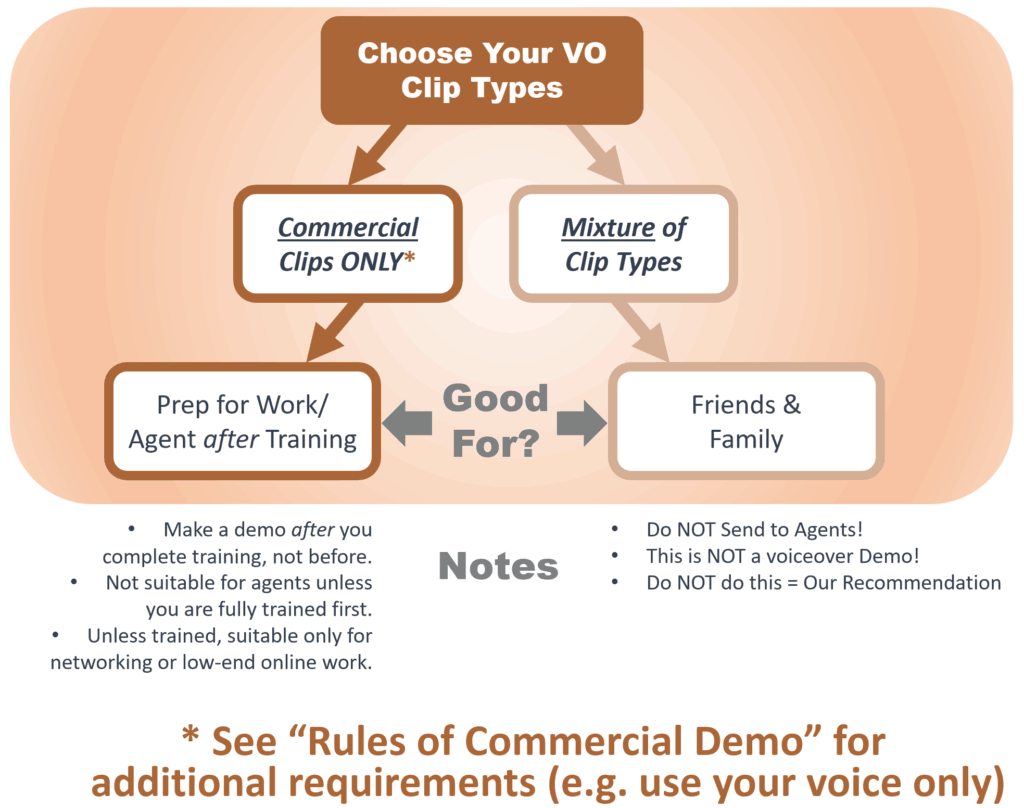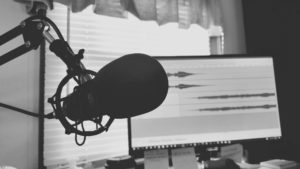Just looking for the summary? Click here. Trying to improve your performance without a coach (directing yourself)? Click here.
Here are the secrets to how a commercial demo is constructed…and the most common errors. If you just want to start making a commercial demo, click this button:
Get Your Demo Evaluated
- Because many people ask for demo evaluations, if you want us to evaluate your demo, your demo clips MUST follow the rules written in the article below. We do evaluations at a very, very low cost, but since most people do NOT follow the rules before sending a demo, we charge $1.99 for a step 1 preliminary evaluation— 1️⃣ click here to order a preliminary evaluation, but first click here for a summary of the rules you must follow (or read this page!) which takes 1-3 days, but often much faster.
After receiving your preliminary evaluation, if you bring your demo into compliance (or if it is already in compliance), step 2 is a summary evaluation. 2️⃣Click here to order a summary evaluation for $7.99. This will touch on your brand voice and money voice, point out performance flaws and how to fix them, and give reasons and suggestions for improvements as well as provide an overall rating. If you did not order a Step 1 preliminary evaluation first, you will be refunded $5.99 and given a preliminary evaluation instead. (If you want detailed followup such as a detailed practice program, production or music-matching tips, we can provide that as well for an additional cost)
What is a Commercial “Demo”?
Nearly 100% of working voiceover talent, whether they specialize in animation, commercials, audiobooks, narration—whatever—do commercials whenever they can. It is generally EXPECTED that if you are a trained voice talent, you can do commercial voiceover. Commercials pay well, and so agents and producers like to work with talent that can do commercials.
This means that if you are not yet a working talent, (1) the first samples of your work are expected to be commercial samples.
A “sample commercial” is a few seconds of your voice performing a commercial script, with music and or sound effects so it sounds like a few seconds from a commercial. Think of it as a “short clip with music added”. A “demo” is a collection of your sample commercials (short clips, sometimes called takes) one after the other in a single audio file. For new talent, many agents will listen to as few as three sample clips, though technically a “full demo” is more than three (more info on that below).
When agents specify they want a “full professional demo”, what they don’t tell you is that usually this means they expect you already have an agent, and are looking for a new/additional agent. Again, many agents will listen to as few as three sample clips from new talent.
Of course, your best work should be first. So the longer your demo is, the more lower quality clips you will have to include. And often, an agent won’t even listen past your first few clips. So when you are new, we (2) suggest starting with only 3-5 clips.
(3) Each clip must obviously be part of a commercial of just your voice! If we can’t tell if it is a commercial, or it doesn’t seem like a commercial, or there is or it seems like there is another voice, don’t include it! No audiobook, animation, narrative or other types should be included. (Exception: Some kinds of narrative sound like a commercial, and these are sometimes okay.)
Here is a brief summary diagram:

How to Get Started
Whether you want to do-it-yourself, or just get an introduction to demos, read on! This is written more for beginners who want to do it themselves, but everyone can learn something here. (Skip down to “Commercial Demo Rules” if you want to dive right in.)
If you have a home studio and want to make your own demo, you can licence music for your demo for under $10, and that plus your time can be your only cost.
For pros in top marketplaces who are already working and have $1500-$4000 to spend, call around and ask agencies which demo producers they recommend. But making a demo for people new to voiceovers is a common scam in the voiceover training industry. You do NOT need to spend money on an expensive demo if you are not good enough for an expensive demo. And the people selling demos won’t tell you you are wasting your money.
First up: Breaking the rules for those who want to make their own demo. If you want to do all three of these things:
- Make your own demo
- Break some rules
- and share your work with someone in the industry…
….be sure to let them know you produced your own demo clips—they will expect you to be a little clueless, and may advise you rather than judge you. While we do NOT recommend this, we’ve learned it is impossible to stop some people. If you present it without comment it may create the impression that you’re trying to fool them, doing a bad job of it, and your effort may “leave a bad taste” instead of having your talent be the main focus. (However, if you’re putting your voice on a low-paying online marketplace, the “rules” are more relaxed. No one from the industry will likely ever hear it there.)
Basics
- We suggest sticking with our demo music library suggestions (or very similar music). Note some links are merely sound effects. The goal is to add and support the emotional intent of your voice and the intent of the script writer.
- Volume levels from track-to-track must be similar—the overall level shouldn’t get significantly louder or softer.
- The kind of music should not take attention away from the voice too much. For example, music with a strong, loud beat often doesn’t work well with voice (though you could go through and quiet each beat manually in post-production, this is usually not recommended).
- The voice should come through more prominently than the music, but the music should be “present” enough to add emotion (music should be neither too loud nor be so quiet as to be barely noticeable).
- The style and energy of music needs to contrast from clip to clip—each clip should seem significantly different from the previous one. More about this below.
Key Points Summary and “Contrast” defined.
First, what is meant by “contrast”? It means that two clips in a row don’t seem the same.
- The topic/category changes, e.g. not two in a row about cars, makeup, healthcare, etc. In general, you should only have ANY topic once, not more than twice overall.
- You sound like you are talking about different topics, sharing different emotions, not identical topics/emotions only with different words. This is tough for new talent, you will tend to sound the same on everything until you get better.
- You don’t repeat styles, e.g not two energetic in a rows, not two serious in a row, etc
- You don’t use similar music: the style and energy of music needs to contrast from clip to clip.
Here is the overall summary:
- Create a minimum of three short commercial only clips that contrast with one another, no voice fading or silence between clips, before solving other problems or trying a full demo. A FULL commercial demo contains 56-64 seconds worth of clips. Closer to :60 is better, but being exactly :60 is NOT required.
- It must sound like it could have come from a collection of actual commercials of your voice only.
- Each track MUST contrast with the previous one.
- Don’t plan “variety”—do your best and only use the best, most authentic of what you get.
- Do NOT try to create a full demo until you can have three great clips that are authentic and different from one another.
- Make CERTAIN your first clip has a real person speech pattern in the first three seconds.
- Radio folks: Do NOT include include anything related to a radio station!
Of course, if you haven’t yet, learn where to get sounds and how to add them to make your own demo.
Exceptions and Trends
If your demo is designed to get you an agent for the first time, or get a better agent, stick to the rules below.
For demos that agencies post of the talent they represent, international celebrities sometimes now only have two-three complete commercials on their demos, and non-celebrity top-talent with agents often now have a long or nearly full commercial at the beginning of their demo. This stands a good chance of becoming somewhat of a standard for all talent—it appears to be a trend.
On their own websites, top talent with several national spots under their belt sometimes also provide a video demo of their commercials (though some may be not exactly as broadcast).
Marketing your Demo Online
I’ll start at the last step, because this can be a lot simpler than many people make it. You must make it possible for people to hear your demo with just a click or two, and you must promote it.
Where to Promote your Demo
EMAIL:
Add a button or link to the bottom of every email you send like this one (you can use this one):
You can use other words, but keep it short. How is this done? To find out, search Google for “how to add a signature to my [service] email” and replace [service] with whatever email service you use, Outlook, Gmail, Yahoo, etc., etc. Want to make your own button? Search Google for “free online button maker”.
Have the button link to a YouTube video that plays your demo, and set it to autoplay. I recommend a YouTube video because it will play more reliably on any browser or device than most other options, and it is the only way to share your demo reliably on most social media platforms. To convert your audio to video, simply use the free one-click EZ Converter service.
SOCIAL MEDIA:
Share the video every time you update your demo. Change out one spot from time to time (or re-arrange) so you can post it again. Ask for feedback. Posts asking questions get more engagement.
WEBSITE:
You’ll also want to embed that video into the top of a free website from Wix.com or WordPress.com or any other free website maker (you can also upgrade to your own domain name at any of these services). Just underneath it, link directly to an mp3 audio file and call the link “Download MP3”.
Why do it this way? First of all, there is no actual video, just a “placeholder” picture shown while your audio plays. All the listener needs to see as they listen is a screenshot of some text, such as
Jane Smith
Commercial Voiceover
However, you should include a direct link underneath on your website because some people will need to save and share your demo, and some mobile settings can make it easier to hear the audio from a direct link than from a video. Link to your website from your social media profiles. Most important: LinkedIn. LinkedIn is the best at showing up in Google search results for your name. Connect to lots of people on LinkedIn to move your name up higher in Google search results. When you complete your first website, share it directly in a post on social media as well.
Recording Quality
You must capture vocal resonance and warmth and avoid tinniness. How? First, use a decent condenser microphone. Second, use the default settings of software such as Audacity, but recording settings must be at least 32 kHz sample rate at a resolution of 16 bits at a minimum. Higher is better (default settings will be higher). Here’s a great article if you’d like to learn more.
Note that the quality of a phone call can be in the range of a 4-8 kHz sample rate (much higher sample rate is preferred, e.g. 32kHz+) so recording with your phone is generally a very bad idea for a demo. Background noise should be minimized, but can be “buried” at bit in the mix. But if your voice lacks resonance and warmth because of using a poor mic, your recording needs to be scrapped.
For an idea of quality standards, take a look a the ACX audio standard toolset inside the free audio editing program Audacity (Want to record ACX audiobooks?Start here; study free)
See How to Direct Yourself From a Home Studio for more tips.
How Important is Production?
 The more polished your demo production is, the less agents believe your talent. And up to 95% of demos are not even listened to all the way through, many rejected in less than 4 seconds because the talent is lacking. So: Production can’t make up for a lack of talent. Put most of your time and money into being a great talent. Whenever I read articles from companies that charge $2,000-$3,000 talking about how great their demos are, I absolutely cringe. Production is irrelevant if talent is lacking.
The more polished your demo production is, the less agents believe your talent. And up to 95% of demos are not even listened to all the way through, many rejected in less than 4 seconds because the talent is lacking. So: Production can’t make up for a lack of talent. Put most of your time and money into being a great talent. Whenever I read articles from companies that charge $2,000-$3,000 talking about how great their demos are, I absolutely cringe. Production is irrelevant if talent is lacking.
And be sure to check what is requested. There are different biases across the industry. For example, some places will ONLY listen to a demo with NO music or sound effects—ZERO production beyond the voice. (This is known as a “dry” demo). And in one marketplace where I know a number of agents, the #2 agent in town ONLY uses a particular studio that the #3 agent NEVER uses. And the most expensive studio in town is the one LEAST liked by the town’s #1 agent. So again, worry less about production and more about talent. No production will please everyone equally.
Look at it from the agent’s perspective: They want to make money from good talent, not listen to demos that they can’t trust anyway. Align your priorities with an agent’s priorities and you’ll be fine. Put your money and time into gaining skill and experience.
Preparing a Demo From Existing Clips
First, learn where to get sounds and how to add them to voiceover to create a demo. ►Your initial goal is to create three short commercial clips that contrast with one another, using your main voice. Consider 3-4 clips to be a short (vs full) demo that you can use instead of a full demo in many situations.

There will always be disagreement among industry insiders as to what is on your demo. We’ve seen an agent suggest moving one take closer to the beginning, and another agent suggest removing that take altogether! Don’t take ONE person’s opinion. Always get a second and third opinion before making changes (unless you already have an agent, then you can simply do what they ask if you wish).
Also, make sure you read the key tricks of sound design (how to add music to voice) before choosing music. Although not everyone agrees exactly on what the basics of a good commercial demo are, here the things you MUST know:
Do a Commercial Demo First
Other demos (narrative, IVR, promo, etc) come later, and don’t matter as much.
Your commercial demo is a collection of actual commercials you have done, OR (more commonly) a simulation of actual commercials. It is NOT a clever production in itself. Please, please, please don’t be clever or over-produce! Don’t have characters talk to one another. Don’t have music or effects without voice. Don’t change the VO to match the music. Don’t put very short clips next to one another, etc, etc. Mainly: Don’t make the production noticeable. ►If it couldn’t have been made from a collection of actual commercials, you have made a mistake. The voice MUST be the star, not the production. (If you can’t help yourself, only do something clever on the very last clip only.)
COMMERCIAL DEMO RULES:
1. Avoid Variety for Variety’s Sake
The #1 mistake beginners make is intentionally including bad acting “for variety.” Bad acting is bad acting! It doesn’t belong on your demo. Use only the most authentic of your recordings. If there isn’t enough variety, try different choices or take more voice acting classes. When someone says “What I’m going to record is…” it’s almost always a mistake. You can’t plan what will be good. If you could you would already be one of the top pros. ►Do your best and only use the best of what you get.
The #1 mistake to avoid if you are a radio DJ: ►Do not include include anything related to a radio station, e.g. avoid anything with call letters, imaging, sweepers, intros, promos, liners, station identification, etc.
Some agents (more than you might expect) will listen to as little as three clips despite saying they only accept full demos, because they generally make a pass/fail decision about a talent in the first three clips anyway. So three clips IS a demo (albeit not a “full” one) that you can share online, or with agents in many cases. ►Do NOT try to create a full demo until you can put together three clips that meet most of the requirements in this post.
2. LENGTH and Music
A typical demo clip is 6-11 seconds long. Yes, they have gotten shorter over the years. A few alternate clips (interjections) can be 1-3 seconds. A FULL commercial demo contains 60 seconds worth of clips.
The total length can be a couple seconds longer or shorter, but not much. The average demo length in a recent survey among professionals was 61.1 seconds, and the average number of tracks was 6.7. Each clip sounds like a portion of an actual commercial.
- You should not have more than two long (10-11 second) clips, and preferably one or none. Only use long clips if the show range/transitions/variety of ability, for example, switching from a problem to a solution and then highlighting the brand name (i.e. showing three skills in one clip). If it’s all the same, cut it shorter, or at least have a musical transition and more than one sound effect. And if you do have two long clips, do not have them both in the first three clips. Optional: You may include 1-3 very short clips, 1/2-3 seconds each, but they should be in between longer clips. A short clip is where you can “cheat” in some variety. Go too far and see what you can get. Don’t exceed 15 or seconds on any track, and again, go longer only if showing a variety of ability.
- A track ends when the voice stops, and starts when the voice starts. There are no music or sound effects before or after the voice, they stop before or at the same time that voice stops, or within 1/5 second or so. There is no space between tracks, or less than 1/5 second of space. Music can start AFTER voice, or end BEFORE voice, but don’t have music without voice.
- You should avoid long pauses in your read, i.e shorten the space between phrases on your voiceover track.
3. Acting Styles and Variety
- Don’t include clips “for variety” that are simply bad acting! It doesn’t matter what you think “would be good to include”: include ONLY what you are able to do authentically.
- Avoid most character voices, particularly in the first three clips. You can be quirky on 1-3 clips (if that is your specialty), but a REAL person—you!—being quirky. Sometimes a stock character—the “Saturday Night Live” version of a real person is okay. But avoid characters that sound like they belong only in an animated movie.
- Authenticity, authenticity, authenticity. 95% of demos are rejected in 3 seconds or less, according to one survey of agents. ►Make CERTAIN your first clip has a real person speech pattern in the first three seconds: no punching, bending or artificial pauses, just smooth natural groups of sound.
4. Contrast and Sound
- ►Each track MUST contrast with the previous one. When you have narrowed down your top takes to five or so, start looking for the portions of each read that contrast with the reads from other scripts you have chosen. This is easier if your clips are not too long.
- Music, script topic, and vocal style MUST all be different from one track to the next. (If it’s not clear what the topic is, that’s fine.)
- A new talent will almost always NOT have enough vocal variety. You can cheat by changing up the music more, and putting the most vocally different clips back-to-back early on. But again, don’t try to create a FULL demo until you can put together three clips that meet most of these requirements.
5. Levels and Fades
- Levels should be near maximum, and consistent from track to track.
- Voice never fades in and out.
- No noticeable silence between tracks.
- Music often does not need to fade in and out, but a very short fade at endings is not uncommon.
- Music should not generally continue after voice: voice ends, music ends.
ACTING TIP
The best takes should sound like first takes. Like you just “tossed off” some comments on something that interests you, excites you, something you know really well. They are also likely to be the ones with the most contrast to one another.
A demo follows the same rule as all other kinds of acting: You have to make them want to listen.
The harder you try for variety, the less you get. ►Overworking doesn’t create the off-the-cuff conversational sound. Record yourself talking to a friend about something that interests you for at least ten minutes to hear your more natural sound.
Why Your Demo Doesn’t Matter as Much as Other Factors:
To succeed quickly when you are starting out, please the agency first, and the voiceover agent second. Several things can matter to an agency MORE than what is on a voiceover demo.
Two things worth doing before you approach a voiceover agent:
• Find some VO work on your own;
• Get some on-camera training and be available to do background agency work (for example, get paid to sit in the background at a casino during a print or commercial shoot). Providing background actors is where agencies make a lot of money. It is NOT a job for models. They need ALL types. The less you look like a model, the more likely they do NOT have someone like you on file and need you to fill a hold in their roster.
Firstly, Demos are well-known to lie. They show more what an engineer can do in editing than what a talent can do in auditions.
Agents don’t believe demos. In fact, the better the demo, sometimes the harder it is to believe. They believe more in industry insiders. This means • talent who have done recent voiceover work for multiple clients outside their day-to-day employer (we recommend a home studio and some easy online work to “check this box”) • have a headshot so that the agency can make money from them as background for on-camera and print • and, ideally, talent who already have an agent. So get an agent then get a better one.
You can be red-flagged and rejected by an agent due to any of these factors:
- Need: Do they need someone like you. Do you fill a hole in their roster?
- Suitability of demo: Does your demo show that you have been well-advised and appropriately trained?
- Commitment: Are you actually someone who does agency work? Do you have a headshot, recent industry work and an agent already? Do you have realistic expectations? Are you going to do this long-term? Having ZERO work history is not a good sign that you can be trusted to commit. There is more hassle than money in voiceover in the short term.
- Believability of demo: Is there reason to expect you might be unable to achieve directable, authentic results equivalent to your demo?
- Skill level evidenced by demo. Yes, this is really only considered fifth.
- Competition: Is your competition more committed and experienced than you? Is there a need for your type locally? If so, is it under-served or over-served?
- Age: Are you young enough to be aging into other types as you grow? Or will you be aging out of the industry all together?
STRATEGY TO GET A GOOD GRADE ON YOUR DEMO
Strategy:
We follow what we call the 3-3-3 demo strategy:
- First three syllables. Most demos are rejected almost immediately. That means the first three syllables have to demonstrate the three acting and appropriateness points below.
- First three seconds. Ditto. Agents may stop listening after three seconds. You have to pull them into continuing to listen.
- First three takes. Outside of other factors, your “grade” is pass/fail from your first three takes. If they’re interested after three, the rest of your demo is just reasons to reject you.
Acting:
To get an agent to continue listening, each of your first three takes, particularly the first one, must meet these criteria:
- Authentic conversation: Real person talking to real person. Do you understand how to speak in your own personality and demonstrate your brand voice?
- Commercial intent: Clearly this is a commercial. Not some other kind of writing. You have a strong point-of-view (believe what you are saying, believe in the product/solution).
- Voiceover: Is your performance voiceover instead of some other form of acting? Do you get how your brand voice is used in the marketplace? (Are you attempting appropriate acting for your voice type).
Appropriateness:
Then you are graded additionally on professional production and guidance.
- Is this cluelessly produced? Distracting errors? Do most clips average 7-9 seconds in length, e.g. are there enough clips? Is there no more than one clip over ten seconds?
- Is there clear contrast between takes? Do two takes in a row sound the same? Are you attempting enough different things to demonstrate acting skill?
- Are you trying things you clearly aren’t good at? Are too many takes a misguided attempt at “variety”?




Trackbacks/Pingbacks